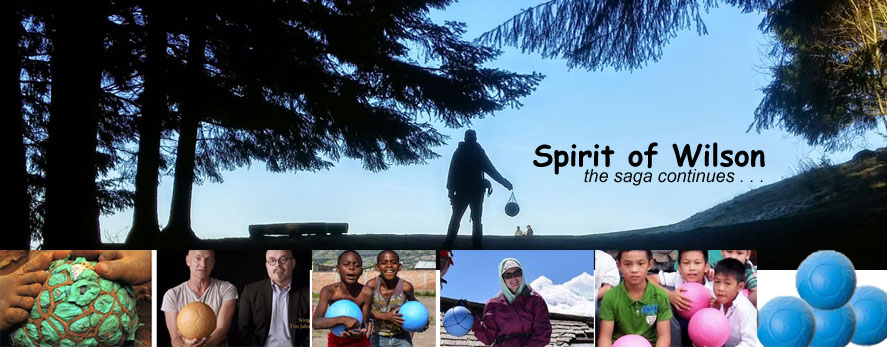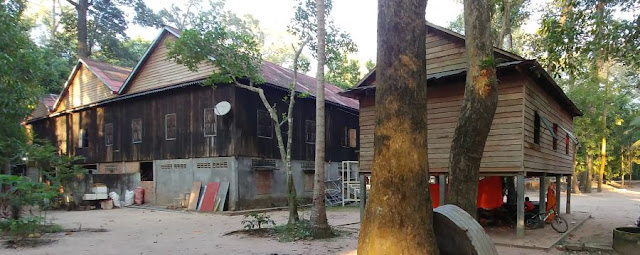 |
My friend, Jay, with Vuthy, a survivor of the Khmer Rouge
|
Seattle, Nov. 22, 2018 --Less than a week ago, two remaining Khmer Rouge ringleaders were
given life sentences for their participation in the Cambodian genocide in the late 1970s. That was a timely announcement, because I had returned only a week earlier from Cambodia, after an interview with a man who was enslaved by the Khmer Rouge. His name is Vuthy.
I've known Vuthy for more than four years, having met him in 2014 on my first visit to Cambodia. I was accompanying my friend, Jay Hastings, who has been operating a no-interest loan for Cambodian fishing villages for the past 10 years.
 |
2014--Jay consults with Vuthy during a visit to a fishing village.
|
Vuthy was working for the Cambodian Fisheries Administration. He was involved in transporting us to fishing villages and acting as interpreter. Now four years later, I've aged a bit, but he looks as young as ever, and it was good to see him again. Before I returned, Jay asked me to interview Vuthy to produce a brief biographical sketch for the doners to his no-interest loan program. The interview took place Nov. 10, 2018, at the Phnom Penh Ratanak Hotel the day we returned to the States. Time was short, so this is only part of what could be a much larger story. But it offers a perspective we all can learn from. Here it is:
Vuthy's Story
Vuthy believes he was born about 1962, the year of the tiger. He doesn't know the date, because his mother, while she was good with numbers, wasn't so good with words; she was functionally illiterate, and yet she was the primary breadwinner in a family of 8. She was a merchant and a lender of sorts. Sometimes she was paid back in rice; she made a point of receiving the rice when it was cheap and selling it when it was dear. This particularly worked well for her when farmers produced only one crop a year. The family lived on rural land in Kampong Thom Province. Their house rested on a slab foundation and was served with an indoor squat toilet. The merchandise she sold from the home included food, clothing and farming tools.
Vuthy's mother was industrious and frugal. She never spent money on entertainment; she never went out to dinner, preferring to curtail expenditures by cooking at home. When one of Vuthy's sisters purchased an entire kilo of pork for the family, mother was not pleased for the daughter's spendthrift ways.
Vuthy's father was capable and literate, but less driven. He was a chess addict and spent a lot of time at the game. But he also was a carpenter who made tools for rice mills, bamboo baskets and fish traps and houses. And although he did not directly farm, he hired farm workers for the family's land.
Still, mother was the major breadwinner of the family, and she set the tone of life in the home. It was largely due to her drive that her children had the education that had escaped her. Of the six children two girls started secondary school and one finished; one boy finished secondary school and two completed college. Vuthy has a Master's Degree. The children came in three year intervals except for the third, who arrived five years after Vuthy was born.
The birth order of boys and girls from the oldest was B-G-G-B-B-G. Vuthy was the third boy and second from the youngest. When he was 9 years old, he served as a monk for a few years. Vuthy's father died in 1985 at 70 years of age, most likely from kidney disease. His mother passed in 1997, five years after she sustained a stroke that left her at least partially paralyzed and bedridden.
Rural life was a key to survival
During the 1970s, when Pol Pot's Khmer Rouge fought Lon Nol for control of the country, the family's rural life style became their best friend. As the Khmer Rouge ascended to dominance they envisioned three categories for the inhabitants of Cambodia, soon to become Kampuchea. Category one involved people who lived a rural life style unsullied by capitalistic culture. Category two included those from rural society who were exposed to capitalistic society, but were still forgivable. Category three were those largely identified as the enemy, with thousands destined for extermination.
Vuthy's eldest sibling, a brother, was an accountant for the Marines with Lon Nol; as the Khmer Rouge gained the upper hand, he disappeared. His fate is unknown. Vuthy was moved from the countryside under Lon Nol's policies to a place in Kampong Thom Province for two years where he was tainted with capitalistic exposure. However, because of his rural background, he, his parents, and his other siblings were among the acceptable or forgivable. His parents came through relatively unscathed.
 |
Enemies of the state--adults and children destined for torture and execution at notorious S-21 camp.
|
 |
Former enemies of the state. Click on Killing Fields, for 2014 blog post.
|
Those who did not fare well were soldiers who had served Lon Nol; people of Vietnamese heritage, including the descendants in mixed marriages; and police. It was difficult for individuals to conceal their heritage, because the elders of the villages knew those in the community and could turn them in. From what Vuthy shares, it appears he had reason to be afraid, but not terrified. It seems that he was not directly threatened with death, but he witnessed people who were marked for death. This included one occasion where he saw an individual he recognized fleeing with his hands tied behind his back; shortly afterward, a group of Khmer Rouge sympathizers showed up, probably in search of him.
 |
Vuthy climbing palm
|
Giving up possessions
At first, under the Khmer Rouge, families could stay put and cooperate with one another. But that changed, and people became isolated. They had to give up their possessions, including their homes and their land. Parents were separated from their children, who were sent to camps. Vuthy's only possessions were his clothing, a plate, bowl and spoon. You lined up for two meals a day and food was placed on your plate or in your bowl. Men and women were separated, and sexual activity was prohibited, except for couples who obtained permission to marry. It may have been a moot point, because people were too exhausted to engage in sex.
10-day work week, morning calisthenics, disease
Vuthy might work six months at a time at different locations. In one instance his job was to haul a cubic meter of earth each day to an earthen dam. Due to the amount of work and the meager rations, his ribs showed and he was constantly weak. He found it difficult to think clearly. He slept side-by-side with other children in a long structure much like a chicken house. At 5:30 a.m. a whistle blew and the children were required to perform military-style calisthenics. There was no breakfast, and no holidays. A day off came after 10 days of work. He suffered from malaria, diarrhea, fevers and an intestinal ailment. Ironically, the reservoir he worked on still operates, although it is situated in a location where it is not easy to see.
In 2014, while visiting one fishing village, Vuthy demonstrated a skill he developed after the Khmer Rouge were driven out of power -- climbing coconut palms, using stubs of leaves on a bamboo pole like rungs on a ladder. He would collect liquid which was turned into sugar, which became his income.
Interview ends
We ran out of time. Jay and I were flying home in the evening, and Vuthy had an appointment. Maybe there will be more to tell in the future. But I came away from the interview with one observation that perhaps will benefit us all: I'm guessing that the secret to the Khmer Rouge's success was to abuse some groups more than others so that the entire population did not revolt. I am wondering whether, although things were bad, a majority of the population was kept ignorant of how bad things had really become. A kind of perverse divide and conquer.
The message here is that for democracy to work all people --everyone -- matters, and we have to remember to care and to question.
Love,
Robert














 Religious perspective: Many Cambodians keep a small shrine like the one at the right at the entry way to their homes, to keep evil spirits away. But what about the images below -- one a linga too big for three men to hoist, and the other a Buddha with a protective serpent guarding its back? It's like an enormous phallic symbol next to a crucifix. Forgive me, but I find this fascinating. I ask your forgiveness, because "fascinate" is related to "fascina," phallic symbols which were amulets carried by young Roman boys and soldiers as protection against the evil eye. That's right, those Roman statues and images of penises were involved in navigation, fertility, directional indication, protection, luck and prosperity. Fascina were fashioned into wind chimes to protect and grant fortune to homes. So maybe a linga works like a crucifix.
Religious perspective: Many Cambodians keep a small shrine like the one at the right at the entry way to their homes, to keep evil spirits away. But what about the images below -- one a linga too big for three men to hoist, and the other a Buddha with a protective serpent guarding its back? It's like an enormous phallic symbol next to a crucifix. Forgive me, but I find this fascinating. I ask your forgiveness, because "fascinate" is related to "fascina," phallic symbols which were amulets carried by young Roman boys and soldiers as protection against the evil eye. That's right, those Roman statues and images of penises were involved in navigation, fertility, directional indication, protection, luck and prosperity. Fascina were fashioned into wind chimes to protect and grant fortune to homes. So maybe a linga works like a crucifix.













































































